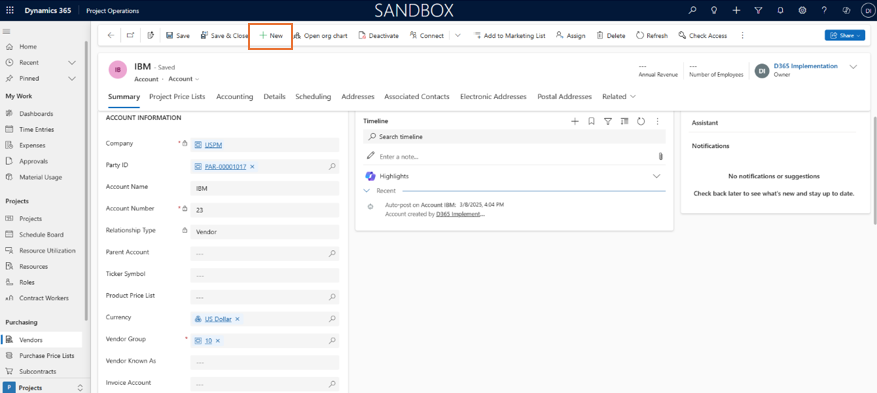Key Concepts in Subcontracting in Microsoft Dynamics 365 Project Operations
- sribatsapatra1
- Mar 27
- 4 min read
Subcontracting is a crucial component of project management within Microsoft Dynamics 365 Project Operations. This blog post explores the essential concepts you need to understand before leveraging subcontracting functionalities in your project operations, especially for resource/non-stocked based scenarios and Lite deployment - deal to proforma invoicing.
Important Note
Fixed Price subcontracts are currently not supported for resource/non-stocked based scenarios in Project Operations.

Contracting Unit on the Subcontract
The contracting unit refers to the division or practice responsible for delivering the project. It is this unit that establishes the contractual relationship with the vendor. Understanding which unit is the contracting entity is crucial as it defines the scope and responsibility within the subcontract.
Example: Consider a large construction company with multiple divisions, such as Residential Construction and Commercial Construction. If the company secures a contract to build a new office building, the Commercial Construction division would be the contracting unit. This division would handle all subcontract negotiations and management for this particular project.
Importance: Identifying the contracting unit is crucial because it defines the scope of responsibility and authority over the project. It ensures that the right division, with the appropriate expertise and resources, handles the specific
Purchase Currency
In Project Operations, the purchase currency is the currency in which the subcontract is created. This is also the currency used to record subcontractor costs on a project. It's important to note that the purchase currency may differ from the project currency, which in turn can differ from the sales currency. This flexibility allows for accurate financial tracking across different geographies and economic conditions.
Example: A U.S.-based company is working on a project in Europe and has subcontracted part of the work to a local European vendor. The subcontract is created in Euros, even though the company's primary operating currency is the U.S. Dollar. This arrangement simplifies pricing cost with the European vendor and provides flexibility of multicurrency.
Importance: It helps in accurate financial tracking and budgeting for subcontractors.
Billing Methods on Subcontract Lines
Project Operations supports various billing methods, reflecting the diverse needs of project-based billing:
Time and Material
Under this method, the cost of time is recorded as subcontractors work on the project and log their time. These transactions are then matched with line items on vendor invoices. Project managers can verify and match vendor invoice lines with the recorded and approved subcontractor time. Upon verification, previously recorded cost actuals are reversed, and new cost actuals based on the vendor invoice are recorded on the project.
Example: A software development project uses subcontractors who log hours worked. These hours are billed at an agreed rate. As subcontractors submit their time sheets, these are matched against the vendor invoices for verification and payment.
Fixed Price
This model is based on fixed milestones. Subcontractor resources may report time, which is reviewed and approved by the project manager. Temporary cost actuals are created on the project upon approval. When a vendor invoice for a milestone is received, the project manager matches the previously recorded cost actuals against the milestone. After verification, the cost actuals are reversed, and milestone-based costs are recorded.
Example: For a marketing campaign project, a subcontractor is hired to deliver a series of advertisements under a fixed-price agreement based on milestones. Each milestone has a set price, which is paid upon completion and verification of the milestone.
Important Note: Fixed Price subcontracts are currently not supported for resource/non-stocked based scenarios in Project Operations.
Project Price Lists on Subcontracts
Project price lists are used to set up purchase prices for time, expenses, and other project-related components. Each price list can have its own date-effective range for a subcontract. However, overlapping effective dates on project price lists for a subcontract are not supported in Project Operations. This ensures clarity and consistency in pricing throughout the subcontract's duration.
Example: A project involving IT system upgrades might have different price lists for hardware (materials), software licenses (materials), and technical support (time).
Importance: Having distinct, effective-date-specific price lists ensures that pricing remains consistent and transparent throughout the subcontract’s duration, preventing any overlap and confusion.
Transaction Classes on Subcontracts
Project Operations categorizes transactions into four classes:
Time
Expense
Material
Fee (Note: Fee is a revenue-only transaction class and is not applicable in the context of purchasing.)
These classifications help in organizing and managing purchase costs, which can only be estimated and incurred for Time, Expense, and Material transaction classes.
Example: For a construction project, transaction classes allow the project manager to categorize costs accurately — labor (time), building materials (material), and travel expenses (expense).
Purchase Pricing Dimensions
Pricing dimensions define the attributes used for purchase price setup and defaulting on time transactions. In purchasing contexts, Project Operations supports only fixed dimension sets for these setups. For subcontract lines and subcontract time transactions, the attributes typically include Role and Bookable Resource. This structure aids in maintaining consistent pricing strategies across various projects and subcontractor engagements.
Understanding these key concepts will help you effectively manage and optimize subcontracting functionalities within Microsoft Dynamics 365 Project Operations, ensuring smooth operations and strategic financial management in your project-based activities.
Example: In a consulting project, different consultants (bookable resources) might have different roles which influence their billing rates. These roles are part of the pricing dimensions.
Importance: Pricing dimensions help in maintaining consistent pricing strategies across projects, ensuring that financial management is both strategic and systematic.




Comments